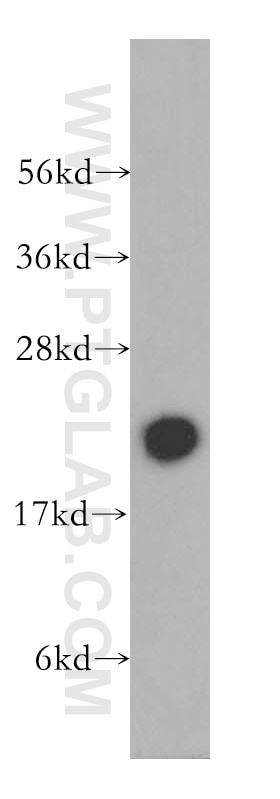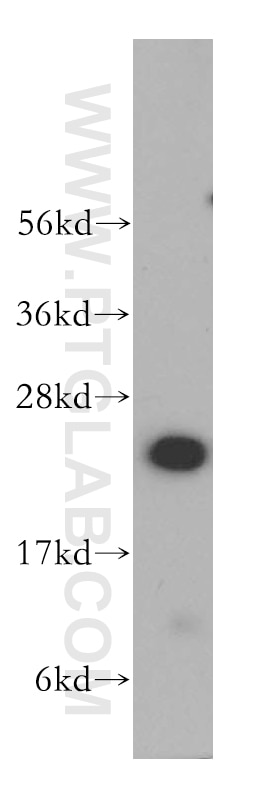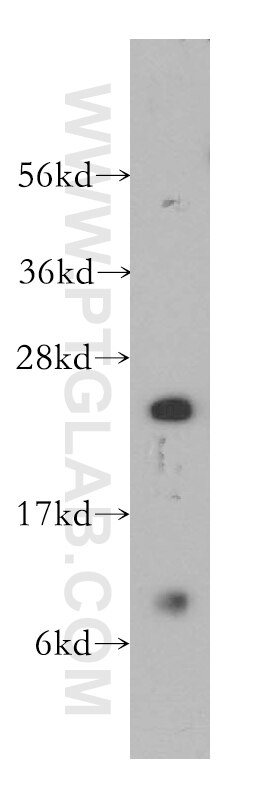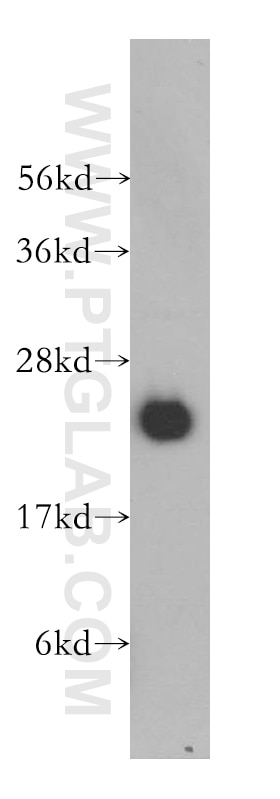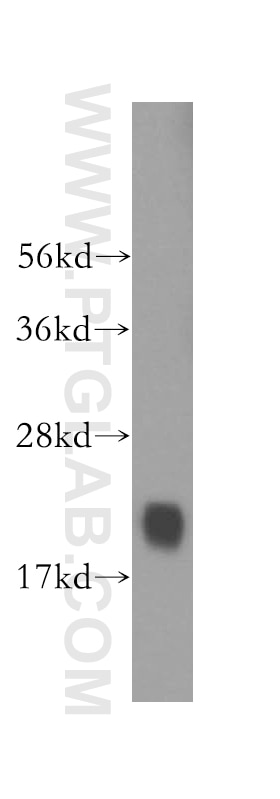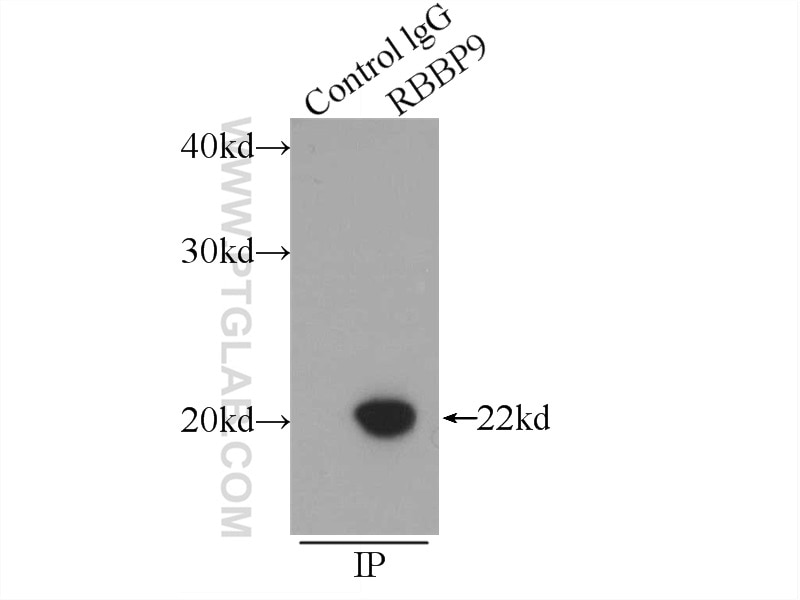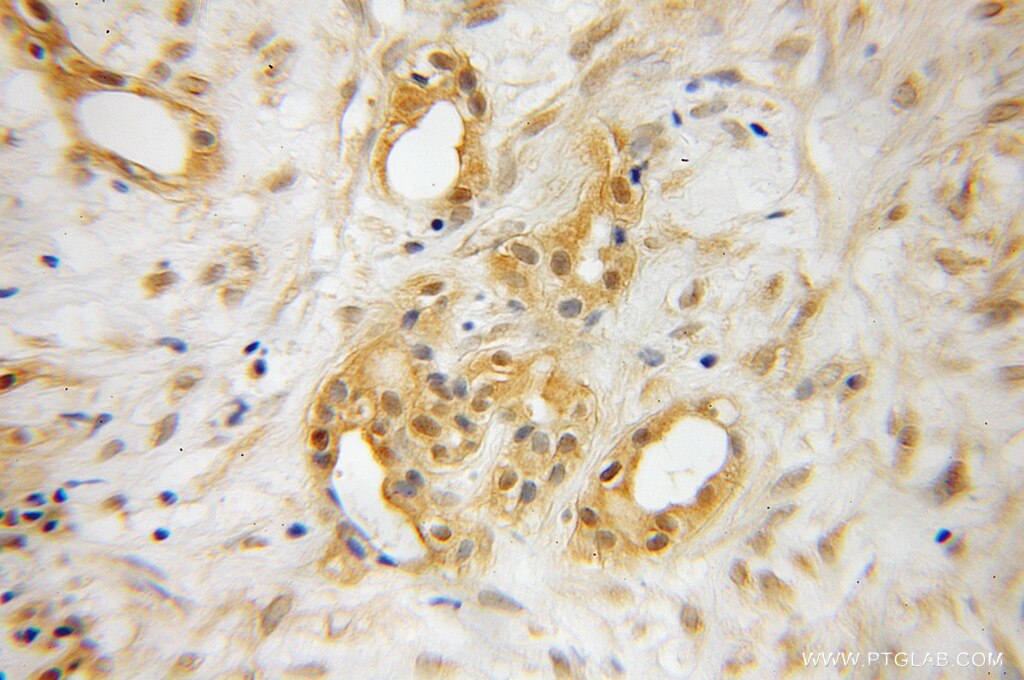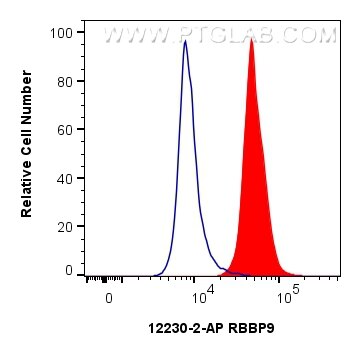- Phare
- Validé par KD/KO
Anticorps Polyclonal de lapin anti-RBBP9
RBBP9 Polyclonal Antibody for WB, IHC, FC (Intra), IP, ELISA
Hôte / Isotype
Lapin / IgG
Réactivité testée
Humain, rat, souris
Applications
WB, IHC, IF, FC (Intra), IP, ELISA
Conjugaison
Non conjugué
N° de cat : 12230-2-AP
Synonymes
Galerie de données de validation
Applications testées
| Résultats positifs en WB | tissu testiculaire de souris, cellules A375, tissu pulmonaire de souris, tissu pulmonaire humain, tissu splénique humain |
| Résultats positifs en IP | tissu pulmonaire de souris |
| Résultats positifs en IHC | tissu de cancer du pancréas humain il est suggéré de démasquer l'antigène avec un tampon de TE buffer pH 9.0; (*) À défaut, 'le démasquage de l'antigène peut être 'effectué avec un tampon citrate pH 6,0. |
| Résultats positifs en FC (Intra) | cellules BxPC-3, |
Dilution recommandée
| Application | Dilution |
|---|---|
| Western Blot (WB) | WB : 1:500-1:3000 |
| Immunoprécipitation (IP) | IP : 0.5-4.0 ug for 1.0-3.0 mg of total protein lysate |
| Immunohistochimie (IHC) | IHC : 1:20-1:200 |
| Flow Cytometry (FC) (INTRA) | FC (INTRA) : 0.40 ug per 10^6 cells in a 100 µl suspension |
| It is recommended that this reagent should be titrated in each testing system to obtain optimal results. | |
| Sample-dependent, check data in validation data gallery | |
Applications publiées
| KD/KO | See 2 publications below |
| WB | See 5 publications below |
| IHC | See 2 publications below |
| IF | See 1 publications below |
Informations sur le produit
12230-2-AP cible RBBP9 dans les applications de WB, IHC, IF, FC (Intra), IP, ELISA et montre une réactivité avec des échantillons Humain, rat, souris
| Réactivité | Humain, rat, souris |
| Réactivité citée | Humain, souris |
| Hôte / Isotype | Lapin / IgG |
| Clonalité | Polyclonal |
| Type | Anticorps |
| Immunogène | RBBP9 Protéine recombinante Ag2868 |
| Nom complet | retinoblastoma binding protein 9 |
| Masse moléculaire calculée | 186 aa, 21 kDa |
| Poids moléculaire observé | 22 kDa |
| Numéro d’acquisition GenBank | BC015938 |
| Symbole du gène | RBBP9 |
| Identification du gène (NCBI) | 10741 |
| Conjugaison | Non conjugué |
| Forme | Liquide |
| Méthode de purification | Purification par affinité contre l'antigène |
| Tampon de stockage | PBS with 0.02% sodium azide and 50% glycerol |
| Conditions de stockage | Stocker à -20°C. Stable pendant un an après l'expédition. L'aliquotage n'est pas nécessaire pour le stockage à -20oC Les 20ul contiennent 0,1% de BSA. |
Informations générales
RBBP9, also named as BOG, RBBP10, RBBP-9, RBBP-10 and Protein BOG, belongs to the RBBP9 family. It may play a role in the transformation process due to its capacity to confer resistance to the growth-inhibitory effects of TGF-β1 through interaction with retinoblastoma and the subsequent displacement of E2F-1. RBBP9 is a tumor-associated serine hydrolase activity required for pancreatic neoplasia. It mediates suppression of TGF-β signaling is required for E-cadherin expression as loss of the serine hydrolase activity leads to a reduction in E-cadherin levels and a concomitant decrease in the integrity of tumor cell-cell junctions..RBBP9 protein levels were equivalent in paired primary tumor and nonneoplastic specimens(PMID: 20080647) The genes CyFIP2 and RbBP9, which are also miss-expressed in ALS hMSC, could serve as diagnostic biomarker tools for detection of ALS in blood samples.
Protocole
| Product Specific Protocols | |
|---|---|
| WB protocol for RBBP9 antibody 12230-2-AP | Download protocol |
| IHC protocol for RBBP9 antibody 12230-2-AP | Download protocol |
| IP protocol for RBBP9 antibody 12230-2-AP | Download protocol |
| FC protocol for RBBP9 antibody 12230-2-AP | Download protocol |
| Standard Protocols | |
|---|---|
| Click here to view our Standard Protocols |
Publications
| Species | Application | Title |
|---|---|---|
Proc Natl Acad Sci U S A RBBP9: a tumor-associated serine hydrolase activity required for pancreatic neoplasia. | ||
Cell Mol Gastroenterol Hepatol Retinoblastoma-Binding Protein 9 Suppresses Intestinal Inflammation and Inflammation-Induced Tumorigenesis in Mice
| ||
Antioxid Redox Signal Regulation of the 20S Proteasome by a Novel Family of Inhibitory Proteins. | ||
Exp Hematol Retinoblastoma-binding proteins 4 and 9 are important for human pluripotent stem cell maintenance.
| ||
Dis Markers Two potential biomarkers identified in mesenchymal stem cells and leukocytes of patients with sporadic amyotrophic lateral sclerosis. |
